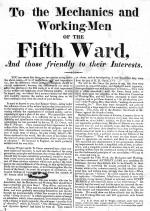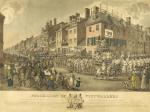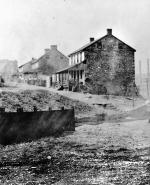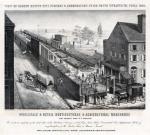![header=[Marker Text] body=[Formed nearby in 1827 as the first central labor council in the nation; recognized as the beginning of American labor movement. Represented workers as a class, not by craft. Advocated for ten-hour day; engaged in political activism and workers' education. ] sign](http://explorepahistory.com/kora/files/1/10/1-A-BC-139-ExplorePAHistory-a0m9h4-a_450.jpg)
Mouse over for marker text
Name:
Mechanics' Union of Trade Associations
Region:
Philadelphia and its Countryside/Lehigh Valley
County:
Philadelphia
Marker Location:
Chestnut and Bank Streets, Philadelphia
Dedication Date:
June 30, 2004
Behind the Marker
Writing from debtor's prison in the frigid winter of 1826-27, an anonymous Philadelphian enumerated "the hardships under which the working people of this city groan." Expensive food and fuel, filthy streets, soaring rents, and grinding poverty were high on this workingman's list. "And just when the city fails us," he continued, "the courts are there to take the last degree of equal law and justice from the common man." Scores of tanners, masons, tailors, grocers, and carpenters in Philadelphia agreed, and wrote long and often about these conditions.
In that horrible winter, more than 800 Philadelphians landed in debtors' prison, the great majority of them working people thrown out of work by sudden turns of the economy or shifting markets for their goods and services. Those who managed to hang on to employment faced long and grueling days of labor, six days a week. In the summer, the workday stretched from sunup to sundown, twelve to fourteen hours a day, in hundreds of small shops throughout the city in "unceasing exertion."
In a widely circulated article printed in city newspapers, a few outspoken writers united across craft lines to call for a ten-hour day. What did it matter, they wrote, if the new political parties gave more and more men the right to vote and participate in political deliberations if education, housing, and basic household necessities were out of reach? How, they argued, could men become good citizens if they worked themselves to the bone and were always too tired to contribute to civic activities? Shortening the workday would be the first important remedy to these fundamental inequalities.
In June 1827, Philadelphia's journeymen carpenters struck for a ten-hour day with no reduction in wages, bringing new construction to a halt and spurring the wrath of the master carpenters who had hired them. When they stopped working, housing and business construction nearly halted. By August, bricklayers, painters, typographers, glaziers, and craftsmen in other trades had walked off their jobs or threatened to do so. By October, they had formed the Mechanics' Union of Trade Associations, the first general union in the nation to form across craft lines, and begun to publish their own newspaper, the Mechanics Free Press. Soon they were organizing benevolent activities to benefit their members and their own slates of candidates "who will support the interest of the working classes."
The Working Men's Party became a political arm of the united crafts in Philadelphia, independent of the rising and popular Jacksonian Democrats. The "Workies," as they were called, ran numerous candidates for local offices and forged coalitions with the state-level Anti-Jacksonian forces who supported educational reforms and economic regulations favorable to Philadelphia's workers.
In 1837, more than fifty different crafts working under the umbrella of the "Workies" achieved their greatest victory when the City of Philadelphia passed legislation for a ten-hour day. Their gains, however, proved short lived. When the Panic of 1837 set off waves of business failures and unemployment that swept across the city, the Mechanics' Union became nearly inactive. Still, this first widespread effort to organize working people for economic justice and political democracy set an important precedent. A generation later, a revitalized labor movement would rise in the coal fields of Lackawanna, Allentown, and Schuylkill Counties and under the strong leadership of men such as John Siney and William Sylvis.
William Sylvis.
In that horrible winter, more than 800 Philadelphians landed in debtors' prison, the great majority of them working people thrown out of work by sudden turns of the economy or shifting markets for their goods and services. Those who managed to hang on to employment faced long and grueling days of labor, six days a week. In the summer, the workday stretched from sunup to sundown, twelve to fourteen hours a day, in hundreds of small shops throughout the city in "unceasing exertion."
In a widely circulated article printed in city newspapers, a few outspoken writers united across craft lines to call for a ten-hour day. What did it matter, they wrote, if the new political parties gave more and more men the right to vote and participate in political deliberations if education, housing, and basic household necessities were out of reach? How, they argued, could men become good citizens if they worked themselves to the bone and were always too tired to contribute to civic activities? Shortening the workday would be the first important remedy to these fundamental inequalities.
In June 1827, Philadelphia's journeymen carpenters struck for a ten-hour day with no reduction in wages, bringing new construction to a halt and spurring the wrath of the master carpenters who had hired them. When they stopped working, housing and business construction nearly halted. By August, bricklayers, painters, typographers, glaziers, and craftsmen in other trades had walked off their jobs or threatened to do so. By October, they had formed the Mechanics' Union of Trade Associations, the first general union in the nation to form across craft lines, and begun to publish their own newspaper, the Mechanics Free Press. Soon they were organizing benevolent activities to benefit their members and their own slates of candidates "who will support the interest of the working classes."
The Working Men's Party became a political arm of the united crafts in Philadelphia, independent of the rising and popular Jacksonian Democrats. The "Workies," as they were called, ran numerous candidates for local offices and forged coalitions with the state-level Anti-Jacksonian forces who supported educational reforms and economic regulations favorable to Philadelphia's workers.
In 1837, more than fifty different crafts working under the umbrella of the "Workies" achieved their greatest victory when the City of Philadelphia passed legislation for a ten-hour day. Their gains, however, proved short lived. When the Panic of 1837 set off waves of business failures and unemployment that swept across the city, the Mechanics' Union became nearly inactive. Still, this first widespread effort to organize working people for economic justice and political democracy set an important precedent. A generation later, a revitalized labor movement would rise in the coal fields of Lackawanna, Allentown, and Schuylkill Counties and under the strong leadership of men such as John Siney and









